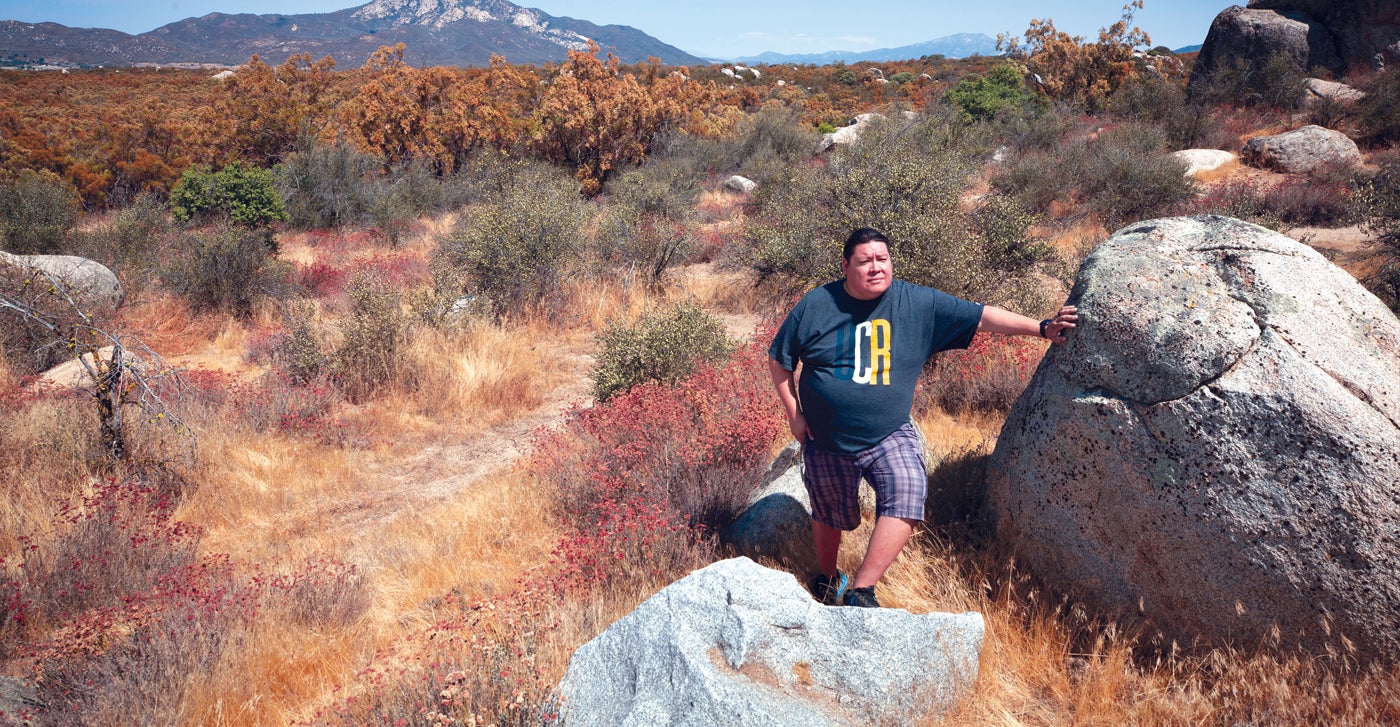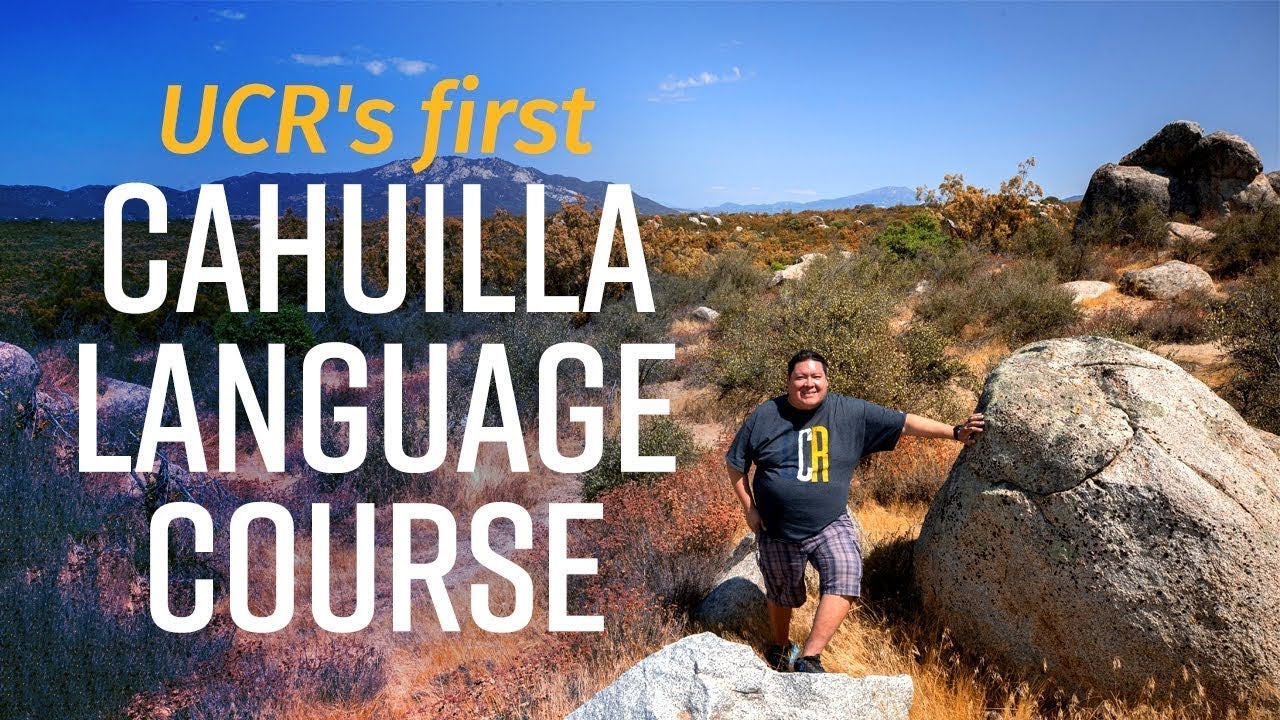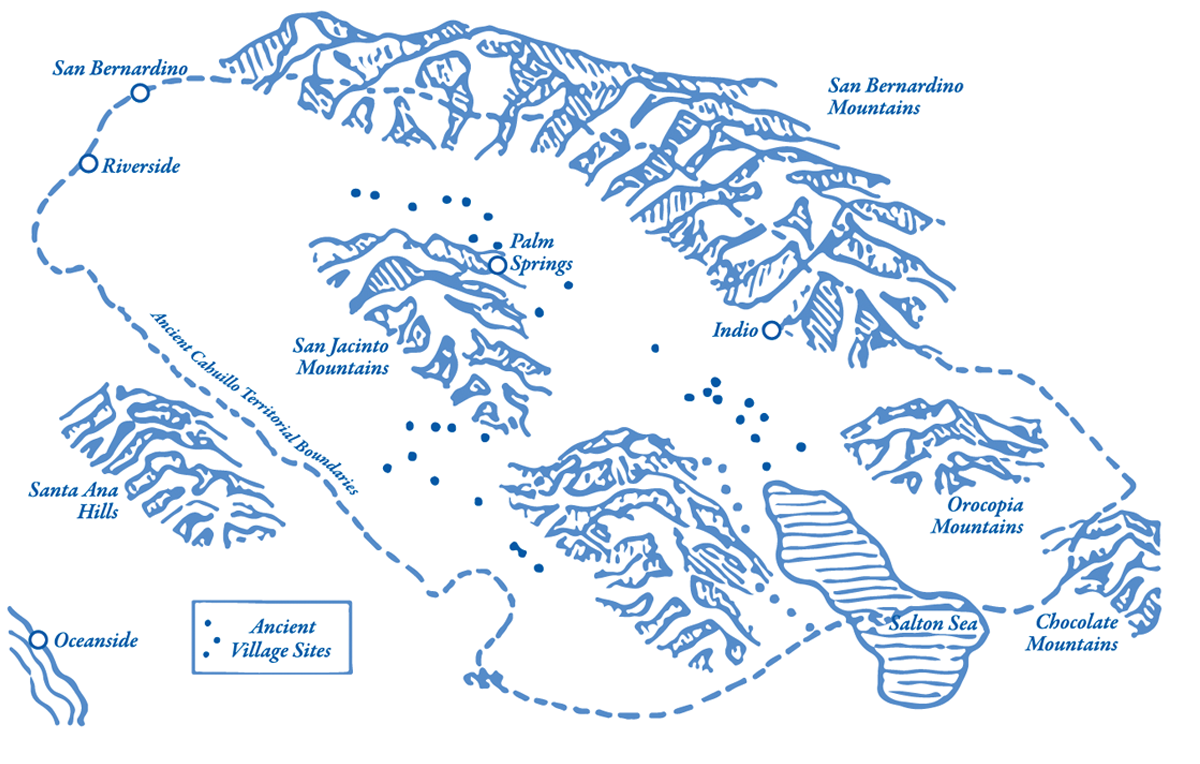William Madrigal Jr. on Cahuilla tribal land in Anza. (UCR/Stan Lim)
A LIVING LANGUAGE
Cahuilla, once close to extinction, is alive and well at UCR.
By Sandra Baltazar Martínez
he Cahuilla, a Native American people whose presence in Inland Southern California dates back thousands of years, have an origin story in which their creator, Mukat, crafted them to perfection along with the Earth, ocean, and sky. William Madrigal Jr. ’11, a Native American Studies doctoral student at UC Riverside and member of the Cahuilla Band of Indians, grew to love this story as a child. He recalls listening to his father, William Madrigal Sr. ’80, tell him why men trekked to Cahuilla Mountain to find spiritual guidance and strength, and why they should never visit the dark spirit, Táqwish, who hides behind a boulder in what is now known as Idyllwild Regional Park. Today, Madrigal teaches three of UC Riverside’s four Cahuilla language classes, which launched in winter 2018 through the Department of Comparative Literature & Languages. UCR is the first UC campus to offer Cahuilla as an accredited language series. The courses are open to all UC students and Cahuilla tribal community members. The Cahuilla currently reside on 10 different reservations, their total population ranging from 3,000 to 5,000, Madrigal Jr. said. Growing up, he felt an obligation to attend college and help revive a language that had been suppressed — and almost eradicated — by federal government mandates. Prior to his current doctoral studies, he graduated from UCR with a bachelor’s degree in anthropology and a minor in Native American studies. Here, he discusses how the Cahuilla language revitalization movement started roughly 50 years ago, when less than a dozen elders spoke the language daily. Because of their efforts, there are now hundreds of Cahuilla learners who are working with linguistic and anthropological materials recorded long ago to revive the language.
WHO ARE THE CAHUILLA?
We used to live in what is now Riverside and San Bernardino counties. UCR itself sits on land where Cahuilla, Tongva, Luiseño, and Serrano people once lived and thrived next to the Santa Ana River — it was a superhighway to the ocean. Knowing our origins were special made me proud growing up. I’m proud of who I am and where I come from. Now there are 10 existing Cahuilla sovereign nations, all spread from the high desert in San Bernardino County to San Diego. When the government sent us to reservations, our people were separated, so we each had to work in our own space to create livelihoods, to live off the land, including cattle ranching.
Cahuilla: A UC Riverside class based on culture, history, philosophy
HOW DID THE REVITALIZATION EFFORT BEGIN?
The last 20 to 25 years have been a real push to revitalize the language, but this was an effort that started 40 to 50 years ago. We knew then we needed to intervene in a drastic way. The decline in the language was caused by events in history, starting when the U.S. government put us in reservations about 150 years ago. The first thing they wanted to take away was the language and with that came the songs, culture. They institutionalized boarding schools and children were punished for speaking Cahuilla, the consequences of which we are still seeing today. I was fortunate enough to grow up on the reservation, to have access to elders and parents who placed a high value on education. All of my nine siblings are either in college or are college graduates. Now there are hundreds of Cahuilla learners who are working with linguistic and anthropological materials recorded long ago to bring Cahuilla back. My parents became language teachers themselves. Each of the 10 reservations has their own unique classes, programming, and publications. Language is a way of life; I was born into it. In conversations with the elders, they kept telling me I had a responsibility. From a very young age, I knew I needed to discipline myself in order to become fluent in Cahuilla.
WHY TEACH CAHUILLA AT UCR?
The interesting thing is that Cahuilla is not a foreign language. It’s very much local and indigenous to Riverside County. Students are learning more than just the mechanics of the language. They are introduced to the Cahuilla culture, philosophy, and worldview. The class series was conceptualized by students and the UCR administration. This has been a long time coming, starting with my distant relative Rupert Costo, who was a big proponent and supporter of the next UC school establishing in Riverside. He understood the importance of education, of giving people access. But introducing a new course is complicated; it’s a long process, and it requires financial support. It’s a four-class series, including three lower-division courses and one-upper division class taught by a doctoral student from UC San Diego. This series satisfies undergraduate foreign language requirements for most of the College of Humanities, Arts, and Social Sciences majors. With these courses, we’re trying to save the essence of our identity, inextricably linked to the Cahuilla culture.
WHAT’S NEXT?
The first class was offered in winter 2018, and it has gained popularity since. One of the positive impacts of language revitalization is that many people are starting to reconnect to their culture. There are many digital resources available for tribal members wanting to reconnect with Cahuilla ancestry. For nonnative students, the language class has prompted them to pursue their own culture, their heritage. We start and end class with a Cahuilla birdsong, allowing them to see and hear oral history, oral education, oral immersion. This also leads me to “IndigenizeUCR,” a project led by Gerald Clarke, assistant professor of ethnic studies; and Jacqueline Shea Murphy, associate professor of critical dance studies. Students and Native community members are collaborating to promote Indigenous cultures, traditional sports, food, language, both on and off campus. On campus, an app will allow campus visitors to walk around and capture its vibrant Native presence. We want to keep this going. Language is a key perspective of our culture. Language is everything, from our creation story to the language that is integrated into the land, valleys, rivers, forests, and it’s all in Southern California. It needs to be protected.
This map depicts the location of ancient Cahuilla villages in Inland Southern California. Multiple villages also existed in the Riverside and San Bernardino areas that are not shown here, according to Madrigal Jr. He also noted the close proximity of the Pa’chappa village, near the foot of Mt. Rubidoux, to UCR’s campus.
Source: “Handbook of North American Indians, Volume 8: California”




